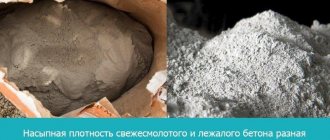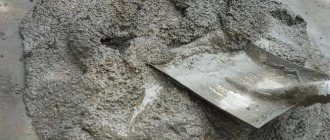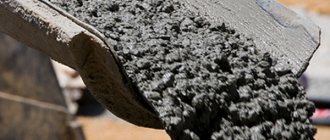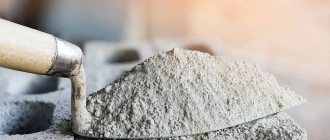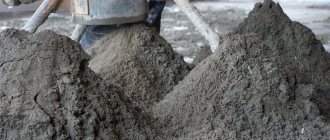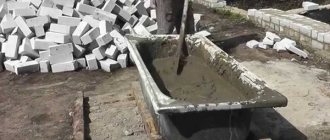Concretes and mortars are artificial materials obtained by mixing binders and fillers. In order to find out how much concrete will be produced from a bag of cement, you need to make some calculations, since manufacturing companies only indicate the mass of cement in the bag.
Required number of bags of cement
If a question arises about the number of packages in one cube of mortar, the calculation will be carried out further taking into account the weight of a cubic meter of cement. The weight of the binder due to its different density and storage conditions may be different, on average:
- Fresh, loose powder: 1200 kg/m3.
- Old, damp and with lumps: 1600 kg/m3.
A more accurate calculation of the mass of cement: density x packaging volume. Taking into account containers of 50 kg: 50/1200=0.042 m3. It would also be useful to calculate the quantity to complete all the work: mass of M300 cement in one cubic meter/volume of container: 0.16/0.04≈4 pieces of 50 kg.
The mass (kg) of the binder in one m3 of the mixture is determined:
- The weight of one package is 50 kg x 4 pieces = 200 kg.
The final step will be to determine the number of bags required for construction work. We calculate the volume of the base, for example, 3 m3. Using M250: capacity in pieces x per area: 4 x 3 = 12 pieces.
How much mortar will be obtained from a 50 kg bag of cement?
“Other factors” include the use of additives – plasticizers. Plasticizers significantly affect the proportional ratio of the components of the solution.
However, if we talk about private “do-it-yourself” construction, the above data can well be used in practice. Ultimately, from a bag of cement weighing 50 kg, a little more than 0.2 m3 of solution is obtained.
Kawabanga! Fire protection of reinforced concrete structures: requirements and application of coatings
The next common type of mortar is a material for sealing cracks and irregularities on walls. In this case, the solution is mixed in proportions of 50/50, only water and cement without filler (sand). In this case, 0.1 m3 of solution is obtained from a bag of cement.
Other options for preparing the solution
Helpful advice - the best option for “ballast filler” is three parts of stone or gravel chips mixed with one part of river sand. In this case, from 1 bag of cement, the yield of the finished material is 0.3 m3 of concrete (mortar).
In any case, before you start preparing and mixing the components, carefully study the instructions with possible proportions available on each bag of cement.
How much concrete will be produced from 50 kg of cement: composition and proportions of components
How to independently calculate all the numbers without errors, and how much concrete of a given grade can be prepared from a bag of cement, read in our article.
What does the volume of the solution depend on?
Now let's go through the technology of preparing the solution to see how the different components of the mixture are distributed in the total volume. For a clear example, let’s take a conventional cube (1000 l). It will be filled as follows:
What should be taken into account when making calculations?
There are some features that must be taken into account when making calculations, in particular:
- brand of concrete mixture used for specific work;
- brand of cement composition;
- the amount of material packed into a bag.
Return to contents
Concrete mix volume calculations
Thus, from one bag weighing fifty kg, the following amount of mortar is obtained:
- for products without reinforcement - 50/200 - 0.25 cubic meters;
- for products with reinforcement - 50 220 - 0.23 cubic meters.
Return to contents
Useful tips
Return to contents
What features of the components are important when making a solution?
Experts highlight the following characteristics:
- cement – mass, activity, hardening time;
- sand – mass, voidness, degree of humidity, presence of organic substances;
- crushed stone – hollowness, mass, degree of moisture, density, structure.
Return to contents
How much cement should be used per cubic meter of concrete mixture?
In addition, it is necessary that the strength of crushed stone and gravel is several times higher than the strength of hardened concrete, in the manufacture of which the above fillers are used.
Return to contents
Conclusion
Failure to comply with the required proportions leads to the fact that the material becomes too thick or liquid. Correct calculation allows you to make a high-quality solution, the use of which will help solve the given construction problem.
Component Requirements
Main components of concrete mixture.
It is important to understand what values of concrete properties and what grade of concrete are required. Therefore, the components of the concrete composition must meet certain requirements to obtain an artificial stone that has the specified quality parameters. When selecting, you should consider:
- for cements - setting time interval, volume (weight), activity;
- for sand - purity, humidity, size and shape of fractions, volume (weight), voidness;
- for crushed stone - size and shape of grain fractions (concentration of lamellar and needle-shaped forms), weight (volume), strength, moisture absorption, cleanliness;
- for water - purity, volume.
These parameters form the final brand indicators of concrete characteristics, as well as equally important intermediate indicators of properties - workability and density of the solution
Inattention to the initial quality of crushed stone, cement, water and sand leads to a shortage of brand values, for example, the strength of structures
The most important parameters are the freshness of the cement and brand characteristics (for example, strength, frost resistance, etc.). The higher the numerical value of the brand, the higher the characteristics. Crushed stone for the mixture is not taken all in a row, but the required fractions (40 - 70, 20 - 40 mm and 5 - 20 mm).
For the filler, the large irregularity of grain shapes and surface roughness (limestone, crushed granite) are important. If gravel grinding with round grains is used, the strength is reduced. The filler should be removed from dust and dirt by washing. This requirement also applies to sand. It, as a sedimentary rock, should consist only of grains up to 0.3 cm in size and should not contain clay impurities.
To clean, the sand mixture should be washed with water. Sand is prepared by sequential sifting through meshes with cells of 0.25, 0.12 cm and 0.315 mm. The last fractions that pass the sieve become fillers
It is also important whether dry or wet sand is used. The moisture in it distorts the actual proportional relationship with other components
The correct water-cement ratio ensures the required duration and intensity of the solution hydration reactions. The optimal amount of water is 40% of the weight of dry cement. Increasing its volume delaminates the mixture, contributing to a lack of strength; insufficient volume stops hardening. The solution should be thick, but not hard, workable, but not leaking through the seams of the formwork. The building materials market also offers the use of ready-made sand and gravel compositions (SGS), obtained by mining gravel and sand.
The river mixture of fillers contains less clay and dust than that mined in quarries. Additional enrichment of such a mixture with sand forms a completely finished composition. However, you should know that the proportion of sand in it should be 30% or higher (gravel up to 70%). Ignorance of the actual content may lead to a distortion of the correct ratio of components.
What to consider when calculating
To calculate how many bags of cement are in a cube of concrete, you need to take into account the following parameters:
- design strength of concrete;
- brand of cement;
- packaging size;
- aggregate fraction;
- proportion of components.
The composition for preparing the concrete mixture is regulated by Building Codes and Rules 5.01.23-83. The document indicates the recommended grades of Portland cement to obtain a monolith with the required characteristics.
For individual construction, concrete is used:
In accordance with the brand of the monolith, the consumption of the binder is normalized.
Cement brand
The main characteristic that needs to be taken into account when purchasing is the brand of cement. It determines the strength characteristics of the binder component. The higher it is, the less consumption of this material.
Kawabanga! Description and operating principle of a mobile concrete plant
In individual construction, the most used are PC grades 350-500.
Areas of application of Portland cement:
- M200, M300 - finishing work;
- M400, M500 - monolithic foundations, walls and other building structures.
You need to pay attention to freshness - strength decreases with long-term storage. According to GOST rules, the shelf life of PC is 1 year from the date of manufacture.
Important! The rule that is used when purchasing a binder is that its grade should be one and a half to two times higher than the corresponding characteristics of the concrete mixture. For concrete M100 you need to take cement M200, etc.
Fillers
Cement consumption per cubic meter of concrete depends on the size of coarse aggregate - crushed stone, gravel and fine aggregate - sand. The standards provide for the use of increasing and decreasing coefficients when fraction sizes deviate upward or downward.
If the size of the crushed stone is less than 20 mm, the amount of binder is increased by 10%, otherwise it is reduced by 5-10%.
The sand fineness modulus is taken into account:
- if it does not exceed 1.5, the PC consumption is increased by 12%;
- up to 2 - by 5%.
Consumption rates for different solutions
Depending on what concrete is needed for, 1 m3 of solution may contain different volumes of cement. In modern construction, concrete mortar is used to carry out four tasks: pouring the foundation, laying building blocks, pouring screed and performing plaster. For each of these types of work, it is assumed that a certain type of mortar with a specified volume of cement will be prepared.
The highest consumption of cement per cube of mortar is obtained when preparing a mixture for masonry or plaster. When pouring a foundation or screed, it is important to use large fillers (gravel, crushed stone, slag), which reduces cement consumption. The purpose of the solution is indicated by the brand (the properties of concrete and the main characteristics depend on it).
concrete according to GOST:
- M100 – 170 kilograms of cement
- M150 – 200 kilograms
- M200 – 240 kilograms
- M250 – 300 kilograms
- M300 – 350 kilograms
- M400 – 400 kilograms
- M500 – 450 kilograms
For plaster
A standard plaster solution is prepared from 3 parts sand and 1 part cement. If the layer is made with a thickness of no more than 12 millimeters, then 1.6 kilograms of M400 cement and 1.4 kilograms of M500 cement are weighed per 1 square meter of plaster. The volume of mortar per cubic meter of masonry can be calculated as follows: 1 m2 x 0.012 m = 0.012 m2 = 12 liters.
On masonry
For a square meter of brickwork one brick thick, you will need at least 75 liters of M100 mortar. The proportion of M400 cement and sand is 1:4. Thus, it amounts to 250 kilograms per cubic meter of sand. How many cubic meters of solution will be needed in total is calculated based on the size of the building.
Water is taken in half the volume. So, if you mix the solution using buckets, it turns out like this: 1 bucket of M500 cement, 4 buckets of sand, 7 liters of water.
For the foundation
To prepare a solution for pouring the foundation, you need to calculate everything correctly. Typically, a solution of grade M100-M300 is used. The strength of M100 is sufficient for low-rise buildings, M150 and M200 are suitable for buildings of several floors. The higher the grade, the stronger the structure will be. For mixing, take cement M300/M400 (1 part binder and 3 parts sand) or M500 (1 part binder and 5 sand).
Cement consumption per cubic meter of solution:
- M50 (based on M400 cement) – 380 kilograms
- M100 (based on M300 cement) – 214 kilograms
- M200 (based on M400 cement) – 286 kilograms
- M300 (based on M500 cement) – 382 kilograms
Such calculations are relevant if the mixture is prepared according to the following proportions: 1 part cement, 2-4 parts sand, 3 parts crushed stone/gravel.
For screed
The proportion for mixing is as follows: 1 part cement and 3 parts sand. Here you can give an example of correct calculations. So, you need to fill a surface of 3 by 4 square meters (12 is obtained) with a layer thickness of 30 millimeters.
Calculation steps:
How much mortar will be obtained from a 50 kg bag of cement?
“Other factors” include the use of additives – plasticizers. Plasticizers significantly affect the proportional ratio of the components of the solution.
However, if we talk about private “do-it-yourself” construction, the above data can well be used in practice. Ultimately, from a bag of cement weighing 50 kg, a little more than 0.2 m3 of solution is obtained.
The next common type of mortar is a material for sealing cracks and irregularities on walls. In this case, the solution is mixed in proportions of 50/50, only water and cement without filler (sand). In this case, 0.1 m3 of solution is obtained from a bag of cement.
Other options for preparing the solution
Helpful advice - the best option for “ballast filler” is three parts of stone or gravel chips mixed with one part of river sand. In this case, from 1 bag of cement, the yield of the finished material is 0.3 m3 of concrete (mortar).
In any case, before you start preparing and mixing the components, carefully study the instructions with possible proportions available on each bag of cement.
Consumption of masonry mixture per 1 m3 of brickwork
| Wall thickness in bricks | ||||||
| 0.5 (12 cm) | 1 (25 cm) | 1.5 (38 cm) | 2 (51 cm) | 2.5 (64 cm) | ||
| Type of brick | Regular (25x12x6.5 cm) | 0.189 m3 | 0.221 m3 | 0.234 m3 | 0.240 m3 | 0.245 m3 |
| Modulated (25x12x8.8 cm) | 0.160 m3 | 0.200 m3 | 0.216 m3 | 0.222 m3 | 0.227 m3 | |
How much concrete will be produced from 50 kg of cement: composition and proportions of components
How to independently calculate all the numbers without errors, and how much concrete of a given grade can be prepared from a bag of cement, read in our article.
What does the volume of the solution depend on?
Now let's go through the technology of preparing the solution to see how the different components of the mixture are distributed in the total volume. For a clear example, let’s take a conventional cube (1000 l). It will be filled as follows:
What should be taken into account when making calculations?
There are some features that must be taken into account when making calculations, in particular:
- brand of concrete mixture used for specific work;
- brand of cement composition;
- the amount of material packed into a bag.
Return to contents
Concrete mix volume calculations
Thus, from one bag weighing fifty kg, the following amount of mortar is obtained:
- for products without reinforcement - 50/200 - 0.25 cubic meters;
- for products with reinforcement - 50 220 - 0.23 cubic meters.
Kawabanga! Description of aerated concrete and ceramic blocks: advantages, comparative characteristics and problematic issues
Return to contents
Useful tips
Return to contents
What features of the components are important when making a solution?
Experts highlight the following characteristics:
- cement – mass, activity, hardening time;
- sand – mass, voidness, degree of humidity, presence of organic substances;
- crushed stone – hollowness, mass, degree of moisture, density, structure.
Return to contents
How much cement should be used per cubic meter of concrete mixture?
In addition, it is necessary that the strength of crushed stone and gravel is several times higher than the strength of hardened concrete, in the manufacture of which the above fillers are used.
Return to contents
Conclusion
Failure to comply with the required proportions leads to the fact that the material becomes too thick or liquid. Correct calculation allows you to make a high-quality solution, the use of which will help solve the given construction problem.
Why is the screed calculated?
A screed is a mixture of cement and sand designed to cover and level the base before laying finishing elements. In addition to the leveling function, the screed hides communication nodes inside itself; floor hydro- and thermal insulation is laid directly on the screed.
There are several purposes for screeds:
- Covering for technical purposes that remains final, such as a garage floor;
- An intermediate element for further installation of finishing materials;
- The screed, carried out as a continuous covering, fills the floor of the entire room and leveling occurs;
- The use of a self-leveling mortar has high fluidity and requires a sealed base.
Due to its fluid structure, no leveling step is required.
How much concrete will be produced from a 50 kg bag of cement?
What should be taken into account when making calculations?
There are some features that must be taken into account when making calculations, in particular:
- brand of concrete mixture used for specific work;
- brand of cement composition;
- the amount of material packed into a bag.
Concrete mix volume calculations
Thus, from one bag weighing fifty kg, the following amount of mortar is obtained:
- for products without reinforcement - 50/200 - 0.25 cubic meters;
- for products with reinforcement - 50 220 - 0.23 cubic meters.
Useful tips
What features of the components are important when making a solution?
Experts highlight the following characteristics:
- cement – mass, activity, hardening time;
- sand – mass, voidness, degree of humidity, presence of organic substances;
- crushed stone – hollowness, mass, degree of moisture, density, structure.
How much cement should be used per cubic meter of concrete mixture?
In addition, it is necessary that the strength of crushed stone and gravel is several times higher than the strength of hardened concrete, in the manufacture of which the above fillers are used.
Conclusion
Failure to comply with the required proportions leads to the fact that the material becomes too thick or liquid. Correct calculation allows you to make a high-quality solution, the use of which will help solve the given construction problem.
Useful tips
When making calculations, it is important to take into account the number of components, know the norms for using cement mortar and the proportions of other ingredients of the mixture. When making concrete mortar for foundation bases, the following proportion is considered optimal: 1:3:5 (cement composition; sand; crushed stone). To more accurately determine the amount of building materials for concrete, you need to learn about their main characteristics. In addition, you should pay attention to what kind of concrete should be made (brand). The consumption of building material components per cubic meter will depend on the listed criteria.
How much concrete can be made from one bag of cement?
Constantly rising prices for building materials force developers to very accurately calculate the need for a particular material. Including the need for cement, as a starting point for the production of concrete.
Technology for calculating the amount of concrete from a bag of cement
Let us immediately make a reservation that it is impossible to give an unambiguous recipe for all occasions. The amount of concrete that will be obtained from one bag of cement depends on the following factors:
- Concrete grades;
- Cement grades;
- “Freshness” of cement;
- The weight of a bag of cement is 20 or 50 kg.
Therefore, within the framework of this article, the most general case will be considered in accordance with the following initial data:
- Concrete grade – M200. Considered the most popular brand;
- Cement grade – M400.
- The weight of a bag of cement is 50 kg;
- The freshness of the cement is “only from the cement plant.”
To calculate how much concrete will be produced from a bag of cement weighing 50 kg, the following assumptions should be made:
- Proportions of concrete components M200: cement 1 part, sand 2.8 parts, crushed stone 4.8 parts, water 0.5 or ½ of the amount of cement;
- The unit of measurement for the amount of concrete is cubic meters (m3);
- Weight of 1 m3 of M200 concrete: 2,400 kg;
Considering that our “1 part of cement” weighs 50 kg (one bag), we calculate the mass of the remaining components for mixing concrete in kilograms:
- Sand: 2.8x50=140 kg;
- Crushed stone: 4.8x50=240 kg:
- Water: 50x05=25 kg.
Types and brands of mixtures
The grade of cement and concrete are two different indicators. M400 grade cement can produce concrete of different grades, which depends on the kilogram of cement per 1 m3 and the volume of fillers. As a rule, to prepare a solution of a certain grade, use cement grade 1.5-2 higher.
In production conditions, you can find cement of the M100 grade, but it is usually not used due to its minimal strength. The most popular brands of cement are M400 and M500, which are used in the preparation of M100-M600 solutions. Other types are also relevant for certain jobs.
The brand of cement is indicated on the packaging in the marking - indicated by the letter M and numbers. The grade is a direct indicator of the strength of the material. In mortar, the strength depends on the brand and volume of cement used. The higher the grade of concrete, the more difficult it is to work with, but the strength will also be higher, as will other performance characteristics.
Where different grades of concrete are used:
- M100 – implementation of the preparatory stage of various works (concrete is often placed in a thin layer on a sand bed under the foundation)
- M150 – foundation for small buildings, screeding and pouring the base as a rough layer, concreting paths
- M200 – pouring garden paths, foundations, blind areas, concrete screeds in garages and residential premises
- M250/M300 – creation of a monolithic foundation, stairs, fences, supports, medium-load floor slabs, blind areas
- M350 – pouring critical structures (floor slabs, monolithic foundations, columns, crossbars, swimming pool bowls, etc.)
- M400 – construction of cash vaults, bridges, hydraulic structures, objects with special requirements
- M450/M500/M550 – the same targets as the M400 brand, also dams, dikes, subways
- M600 - used in the construction of objects that require special resistance to aggressive factors that require maximum strength (reinforced concrete bridges, special-purpose structures, hydraulic-technical objects, etc.).
